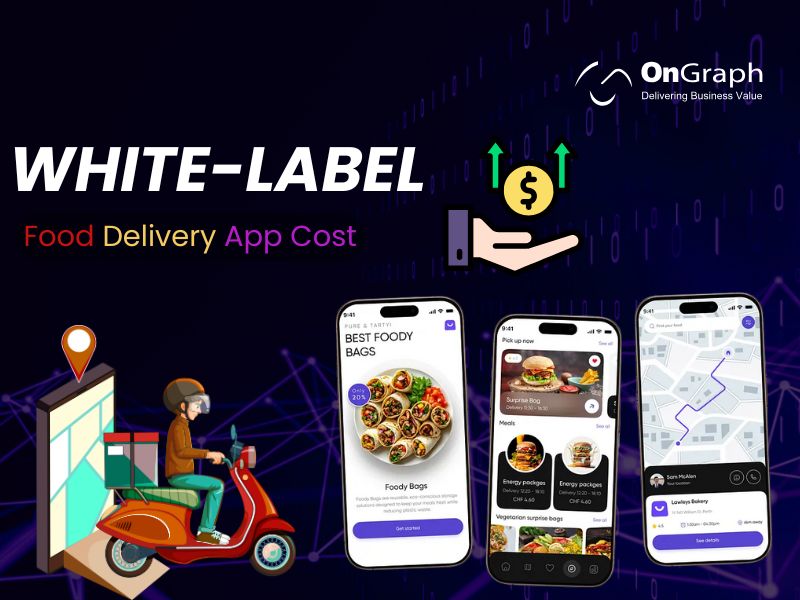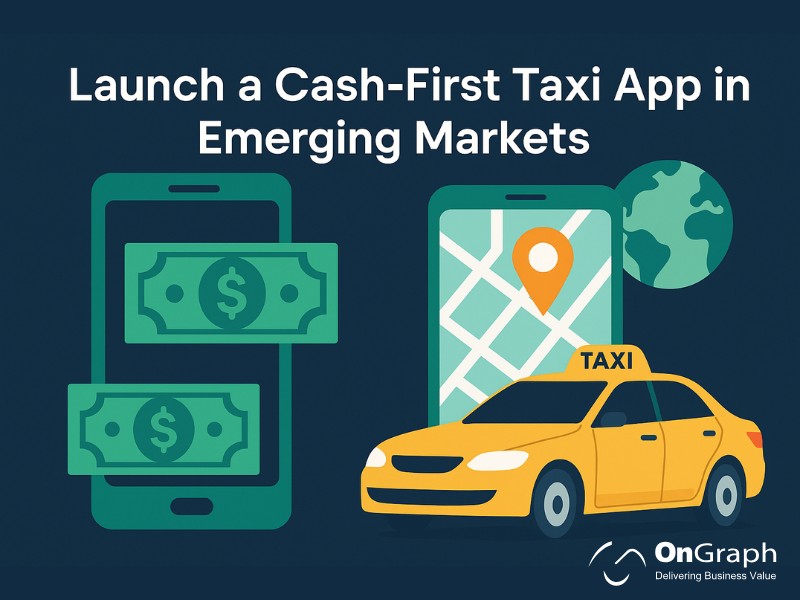In this article
- Average White Label Food Delivery App Cost in 2025
- Detailed Cost Breakdown — From Design to Deployment
- Annual Food Delivery App Maintenance Cost
- How AI Is Revolutionizing the Food Industry?
- Blockchain in the Food Industry — The Next Leap
- Case Study: Medium-Scale Marketplace Deployment
- Factors That Affect White-Label Delivery App Price
- Pro Tips to Optimize Food Delivery App Development Cost
- The Real Cost of a White Label Food Delivery App
A white-label food delivery app is a ready-made software platform that you can customize, rebrand, and launch under your business name.
Think of it as a pre-built foundation that saves you from coding from scratch — you simply tailor it to your needs, such as:
- Adding your logo, colors, and branding
- Configuring payment gateways and delivery zones
- Integrating restaurant, customer, and delivery partner apps
This approach drastically reduces time-to-market and development cost, making it perfect for startups, restaurant chains, or local marketplaces.
Compared to a fully custom solution that can cost upwards of $200,000, a white-label food delivery app can save you 40–60% while delivering identical core functionality.
Average White Label Food Delivery App Cost in 2025
So, let’s answer the big question — how much does a white label food delivery app cost?
According to leading Food Delivery App Development Companies, here’s the 2025 breakdown:
| App Type | Development Cost (USD) | Timeline |
| Basic ready-made food delivery app | $5,000 – $25,000 | 2–4 weeks |
| Customized white-label delivery app | $30,000 – $80,000 | 1–3 months |
| Fully-featured app (multi-vendor like DoorDash) | $100,000 – $200,000+ | 3–6 months |
Detailed Cost Breakdown — From Design to Deployment
To understand the cost to build food delivery app, let’s explore the main phases and their pricing.
1- Discovery & Planning (Cost: $3,000 – $10,000)
- This phase includes requirement analysis, competitor benchmarking, and defining your app’s architecture.
- A clear roadmap prevents scope creep and unnecessary expenses later.
2- UI/UX Design (Cost: $10,000 – $30,000)
- Design directly impacts conversions. An intuitive, well-structured UI helps retain users.
- Design cost depends on the number of screens, branding complexity, and user flow testing.
3- Core App Development (Cost: $35,000 – $70,000)
This is where the heavy lifting happens.
Your app will typically have:
- User app (browse menus, order food, make payments)
- Restaurant app (manage orders, menus, pricing)
- Delivery app (track deliveries, routes, and earnings)
- Admin panel (manage restaurants, users, payments, and promotions)
Development involves multiple frameworks — React Native, Flutter, or native iOS/Android — and backend technologies like Node.js, Python, or Ruby on Rails.
4- Testing & QA (Cost: $5,000 – $15,000)
- Quality assurance ensures bug-free performance, smooth user journeys, and secure transactions.
- Automated and manual testing both add to the cost but are non-negotiable for app reliability.
5- Hosting & DevOps Setup (Cost: $2,000 – $10,000)
- Your app’s performance depends on server infrastructure.
- Modern apps are hosted on AWS, Azure, or Google Cloud for scalability and uptime.
- This includes CI/CD setup, deployment pipelines, and monitoring tools.
6- Compliance, Licensing, & Integrations (Cost: $2,000 – $8,000)
You’ll need to meet data privacy, PCI-DSS, and local food safety compliance.
Add APIs for:
- Google Maps
- Stripe / Razorpay
- Twilio SMS
- Firebase notifications
Each integration adds minor recurring costs.
Annual Food Delivery App Maintenance Cost
Building your app is just the start — maintaining it keeps your business alive.
Ongoing maintenance costs typically range from 15%–20% of the initial development cost per year.
Here’s what that includes:
- App updates (OS compatibility, new features)
- Bug fixes & security patches
- Server scaling & uptime monitoring
- Database backups & storage management
- Third-party API version updates
For example:
If your app costs $100,000, budget $15,000–$20,000 annually for maintenance.
Well-maintained apps reduce churn, improve ratings, and stay compliant with new tech standards.
How AI Is Revolutionizing the Food Industry?
Integrating AI in the food industry is one of the biggest trends shaping 2025’s delivery landscape.
AI Features You Can Add (and Their Cost Impact):
| AI Module | Purpose | Approx. Additional Cost |
| Route optimization | Suggests fastest delivery routes | +$2,000 – $5,000 |
| Recommendation engine | Personalized dish or restaurant suggestions | +$3,000 – $7,000 |
| Demand forecasting | Predicts peak hours or order spikes | +$2,000 – $4,000 |
| AI-powered chatbots |
Automate customer service | +$1,500 – $3,000 |
Integrating these AI modules can increase the food delivery app development cost slightly but dramatically enhances ROI.
Blockchain in the Food Industry — The Next Leap
Blockchain technology brings trust and transparency to food ecosystems.
How It’s Used in Food Delivery Apps:
- Smart contracts ensure fair commission settlements between restaurants, couriers, and platforms.
- Immutable order logs prevent disputes.
- Supply chain tracking increases customer trust in food sources.
A pilot project by IBM and Walmart Food Trust showed blockchain reduced food traceability time from 7 days to 2.2 seconds — a revolution in accountability.
Adding blockchain in the food industry may increase app cost by 10–30%, but it’s a long-term investment in brand credibility.
Case Study: Medium-Scale Marketplace Deployment
Let’s take an example.
Suppose you want to launch a multi-vendor marketplace for a mid-sized city.
Scope:
- User + Restaurant + Delivery apps (iOS + Android)
- Real-time order tracking
- Subscription-based loyalty program
- Basic AI recommendations
Estimated Costs:
- Development: $120,000
- Annual Maintenance: $18,000
- AI & Analytics Integration: $10,000
- Cloud Hosting (AWS): $5,000/year
Total 2-Year Cost: ~ $153,000 – $160,000
This model can easily scale across multiple cities — proving why white-label systems are ideal for rapid expansion.
Factors That Affect White-Label Delivery App Price
- Customization Level: The more you modify UI/UX or add features, the higher the cost.
- Tech Stack: Choosing Flutter or React Native saves 25–30% compared to building separate native apps.
- Location of Developers: Outsourcing to Asia can reduce hourly rates from $100+ (US) to $20–$40 (India).
- Third-Party Integrations: Payment, chat, maps, and analytics all add incremental costs.
- Scalability Requirements: Apps supporting thousands of users simultaneously require stronger infrastructure.
- Security & Compliance: Enterprise clients often need encryption, GDPR, or ISO-compliant development, increasing the price slightly.
Pro Tips to Optimize Food Delivery App Development Cost
- Start with MVP – Focus on must-have features; add advanced features later.
- Choose a proven Food Delivery App Development Company – Experience reduces rework and accelerates time-to-market.
- Negotiate ownership – Ensure your business owns the source code, not just usage rights.
- Plan DevOps early – CI/CD pipelines save hundreds of developer hours.
- Use data-driven scaling – Add servers only when user growth demands it.
The Real Cost of a White Label Food Delivery App
| Category | Estimated Cost (USD) |
| Basic ready-made app | $5,000 – $25,000 |
| Mid-tier customizable app | $30,000 – $80,000 |
| Fully-featured enterprise app | $100,000 – $200,000+ |
| Annual maintenance | 15–20% of initial cost |
Final Thoughts
Building your food delivery platform doesn’t need to break the bank. A white-label food delivery app lets you enter the market faster, test your model, and scale intelligently — all while keeping ownership and flexibility.
In 2025, the focus should be on speed, scalability, and innovation — using AI, blockchain, and automation to create a modern, efficient food delivery ecosystem.
When you’re ready to estimate your own white-label food delivery app pricing, partner with an experienced development company that can guide you from concept to live deployment — with transparent pricing and reliable post-launch support.
FAQs
The average cost of a white label food delivery app can range from $5,000 to $80,000, depending on the complexity and features you need.
-
Basic white-label app: Starts around $5,000 – $25,000, covering core features like order placement, restaurant listings, and simple payment integration.
-
Customized white-label solution: Costs between $30,000 – $70,000 for more features like multi-vendor support, advanced UI/UX design, customer reviews, and loyalty programs.
-
Advanced, feature-rich apps: For full-fledged platforms like UberEats or DoorDash, you could be looking at $100,000 – $200,000+, which includes advanced features like AI-based delivery optimization, real-time GPS tracking, and fully integrated payment gateways.
The final cost depends on the platform (Android, iOS, or Web), third-party integrations (payments, maps, etc.), and the complexity of the customization you require.
Several key factors impact the cost to build a food delivery app:
-
Platform Type: Developing for iOS, Android, and Web increases costs compared to choosing just one platform (e.g., an Android-only app).
-
App Complexity: Basic apps with just food ordering and payment functionalities are cheaper. However, complex features like multi-vendor support, real-time GPS tracking, and AI-powered route optimization will raise costs.
-
Custom Design vs Template: Custom UI/UX designs tailored to your brand can increase development costs significantly, while using a template-based design keeps costs lower.
-
Third-Party Integrations: Integration with payment gateways (like Stripe or Razorpay), SMS APIs, location services, or cloud storage also adds to the overall development cost.
-
Technology Stack: Choosing high-end technologies or microservices architectures increases the cost but helps with scalability, while simpler solutions are cheaper.
-
Location of Development Team: The hourly rate of developers varies depending on their location. For example, developers in the US or Europe charge higher rates than those in India or Eastern Europe.
Maintaining your white-label food delivery app will typically cost 15%–20% of the original development cost annually. For example, if your app costs $100,000 to develop, the annual maintenance fee would be $15,000 to $20,000.
Maintenance includes:
-
Bug fixes and updates to ensure compatibility with new mobile operating system versions (iOS/Android).
-
Server management to ensure the app runs smoothly without downtime.
-
Feature updates to add new functionalities or improve existing ones based on user feedback.
-
Security patches to protect user data and ensure the app complies with privacy laws and regulations.
-
Scalability: As your app grows, you may need to scale your infrastructure, which increases hosting and server management costs.
You should budget for continuous improvements to avoid customer churn and keep up with market trends.
The time required to develop a white-label food delivery app depends on the complexity of the features you want to implement:
-
Basic App (just food ordering, simple menus, and payment integrations): 2–4 weeks.
-
Customized App (advanced features like multi-vendor options, order tracking, reviews): 1–3 months.
-
Enterprise-Level App (features like AI-powered recommendations, blockchain for payment transparency, high scalability): 3–6 months or more.
In general, testing and quality assurance can add 2–4 weeks to the total timeline, depending on the thoroughness of testing (manual, automated) and the complexity of the integrations.
Yes, integrating AI in the food industry significantly enhances app performance and user experience. Here are a few ways AI can boost your food delivery service:
-
Route Optimization: AI algorithms can optimize delivery routes in real-time, reducing delivery time and fuel costs. Companies like UberEats have saved on logistics costs by using AI for dynamic routing.
-
Demand Prediction: AI helps predict high-demand periods (e.g., lunch or dinner rush), allowing restaurants to prepare in advance and efficiently manage resources.
-
Personalized Recommendations: Using machine learning, apps can offer personalized meal suggestions based on users’ order history, preferences, and dietary restrictions, increasing sales and customer satisfaction.
-
Fraud Detection: AI can help detect fraud by analyzing transaction patterns, ensuring secure payments and reducing losses.
-
Chatbots: AI-powered chatbots automate customer service, answering queries instantly and improving user satisfaction.
Blockchain technology can add value to your food delivery app in several ways, particularly in trust and transparency. Here are some blockchain use cases:
-
Smart Contracts: These are self-executing contracts where the terms are directly written into lines of code. For example, once a food delivery is completed, the blockchain can automatically trigger the payment process, ensuring all parties receive their due share.
-
Transparency: Blockchain provides a transparent and immutable ledger of transactions. Users and restaurants can verify order histories, delivery statuses, and payment settlements.
-
Data Security: Blockchain’s encrypted nature ensures that customer data (such as personal and payment details) is stored securely, reducing the risk of data breaches.
-
Supply Chain Transparency: Blockchain allows tracking of food items from farm to table. Customers can see exactly where their food is coming from and whether it meets quality standards.
Adding blockchain to your food delivery app can increase your development cost by 15%–30%, but it provides added value for users and businesses that prioritize transparency, security, and reliability.
Running a food delivery app involves several ongoing operational costs beyond just maintenance and development:
-
Cloud Hosting and Infrastructure: Hosting on cloud services (like AWS, Google Cloud, or Azure) will cost $1,000 to $5,000/month depending on traffic, storage, and data usage.
-
Payment Gateway Fees: Payment processors like Stripe or Razorpay charge a small transaction fee, usually 2%–5% per transaction.
-
Marketing & Customer Acquisition: Running ads, promotions, and incentives to attract users to your platform will require a budget. Depending on your strategy, this can range from $2,000 to $10,000/month.
-
Customer Support: If you have a dedicated support team, this can cost anywhere from $2,000 to $8,000/month, depending on the number of support agents and the complexity of the queries.
-
App Store Fees: For iOS and Android, you’ll need to pay a monthly or yearly fee to keep your app listed on the App Store or Google Play Store.
Overall, running the app could cost between $5,000 to $20,000/month, depending on the scale, traffic, and added services (customer support, promotions, etc.).
About the Author
Let’s Create Something Great Together!
Latest Blog
















